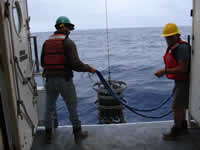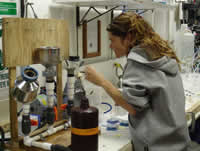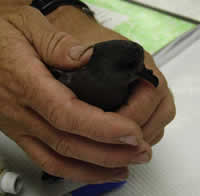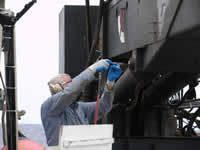


|
The Project Part 3:
Also See: Part 1: Part 2:
|
September 1, 2005
Last night and this morning have been incredibly busy. From the moment we arrived at our location, we have been gathering data. The CTD, which is the instrument we send down to take water samples at different depths, has been cast in time after time. It is giving the scientists an abundance of information and quite a bit of work to do. Everyone works as rapidly as possible to get ready for the next cast. Then we do the procedure over again. There are many steps to the gathering of data. I help at the computer console which controls the CTD bottles. When we want to close a bottle at a certain depth, so the scientists can look close at what is happening there, I get to "fire" the bottle via the computer. After the CTD is brought back on board, samples are taken from all the different bottles. Some samples are filtered, and the filters are put in a deep freeze to analyze later in a more equipped lab. Some samples have chemicals added to them, and then the results are recorded. Barbara has much to do. She filters samples and then looks at the organisms she has captured under the microscope. The coccoliths, or calcium carbonate plates, tell her which species she sees. She then counts them and gathers other information to help determine which ones live where, what they are doing, and how. Today she found a micro-organism in her sample that had obviously eaten a large number of coccolithophores, and was covered in calcium carbonate plates. Last night we had a close encounter with a small seabird called a sooty Petrel. It must have been tired or dazed, but it was on the back deck. When Lee, one of our volunteers, walked up it made no effort to leave. He brought it inside for us all to say hi. Here's a picture. Then Lee took him outside and let him go. These little guys and the albatross are the common seabird out here. Today we've seen a few albatross and a sunfish off the port side. Port is the left hand side of the ship when looking toward the front bow, which may have been named for the loading side at port or the entry port on the left side. Long ago, the left side of the ship was called larboard, but that was changed in 1844 to avoid any confusion with the similar sounding starboard. This information came from The Oxford Companion to Ships and the Sea. There are three Able Body Seamen, Doug A., Doug B., and Pam, on board, and one Bosun, Bo, who oversees the deck and the jobs the three need to get done, as well as his own duties. This part of the crew keeps up on all the daily cleaning and maintenance, such as rust removal, as well as other duties, such as standing watch, radar lookout, winch operator, and operating other ship machinery. Math Questions: The CTD has 12 bottles that hold 10 liters of water each. The scientists take water samples from these bottles. If Brian and Carl take two 125 ml samples from each bottle, how many samples will they have? If it takes Carl an average of 3.5 minutes to process one sample, how long will it take him to process the ones he and Brian took? If a Petrel could fly 32 miles an hour, how long in hours and minutes would it take him to fly to our ship 336 miles from the nearest coast, assuming he didn't stop and float along the way? Ocean Trivia: Many things scientists learn turn into major benefits for us. One example of this is the study of coral leading to the discovery that the architecture and chemistry of coral are very close to that of human bone. Today it is used to replace bone grafts in helping human bone to heal quickly and cleanly.
|




